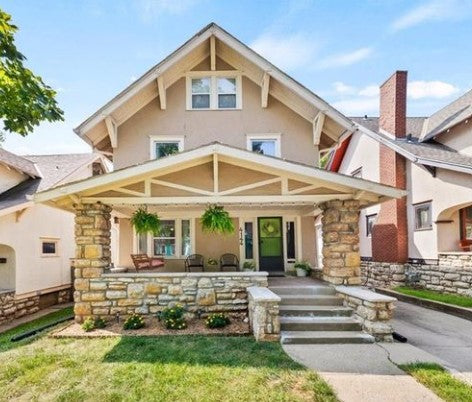
Mixing Mid-Century Modern Pieces in to Arts and Crafts Style Homes
Share
Especially in Kansas City, craftsman-style architecture dominates the landscape because of the major growth of the city in the early 1900's. Many new homeowners aren't sure where to start when furnishing their historic new home. But I'm here to tell you, you don't have to furnish with furniture from the same period as the home. Mixing Mid-Century Modern furniture with Craftsman architecture can create an interesting and balanced aesthetic, combining the clean lines and functional form of Mid-Century design with the warmth, craftsmanship, and natural materials of Craftsman style. The key to making this fusion work is finding harmony between the distinct characteristics of both styles. Here are some tips for achieving a successful blend:
1. Focus on Common Elements
Both styles appreciate natural materials and a focus on craftsmanship. Mid-Century Modern tends to feature clean lines and organic forms, while Craftsman emphasizes hand-crafted details and woodwork. You can merge these qualities by:
- Choosing wood furniture with clean lines but showing natural wood grain (Mid-Century Modern-style furniture walnut and teak work well).
- Ensuring your wood finishes (whether on the furniture or architectural elements) complement each other. For instance, a deep walnut wood tone on the furniture will look great with oak or mahogany finishes commonly found in Craftsman homes.
2. Use of Color
Mid-Century Modern design often uses bold, saturated colors (think mustard yellow, teal, and olive green), while Craftsman interiors tend to lean toward earthy, muted tones. Here are ways to bridge this gap:
- Accent colors: Use Mid-Century colors in smaller doses, such as pillows, rugs, or artwork, to keep the space feeling vibrant without clashing with the warm, earthy tones of the Craftsman architecture.
- Natural hues: Choose natural, earthy fabrics (like wool, linen, and leather) for Mid-Century furniture to integrate it into the more grounded palette of a Craftsman home.
3. Integrate Clean Lines with Handcrafted Details
The furniture's clean lines (a hallmark of Mid-Century Modern) can contrast nicely with the more intricate woodworking and custom cabinetry found in Craftsman design. Pair a sleek, minimalist sofa or armchair with Craftsman-style woodwork, such as exposed beams, built-ins, or handcrafted trim.
- Opt for Mid-Century chairs with solid wood legs that mirror the custom, hand-crafted look of a Craftsman dining table or cabinet.
- A modern Eames lounge chair, for example, could sit comfortably in front of a Craftsman-style fireplace or built-in bookshelf.
4. Balance with Textures
Craftsman design is known for its rich textures, such as thick wood trim, exposed beams, stone fireplaces, and built-in wood furniture. Mid-Century Modern, while simpler, can still bring in texture through its upholstery and materials like leather, wool, and teak.
- Pair a textured, woolen Mid-Century Modern rug with a Craftsman-style hardwood floor.
- Incorporate materials like glass and metal in Mid-Century pieces (such as a coffee table with a metal frame and glass top) to contrast with the more rustic, solid wood Craftsman elements.
5. Lighting Choices
Craftsman homes often feature built-in lighting, such as sconce lights or lantern-style fixtures. For Mid-Century Modern elements, look for sleek, sculptural lighting that complements the space without competing with the woodwork.
- A statement pendant light in a clean, geometric Mid-Century style could hang over a Craftsman dining table.
- Look for table lamps with wood bases or natural materials, such as ceramic or stone, to blend both aesthetics seamlessly.
6. Art and Accessories
Art can tie both styles together. Consider abstract or geometric prints that reflect Mid-Century Modern design but framed in wood or using a color palette that complements the earthy tones of the Craftsman style.
- For example, a framed vintage Mid-Century Modern painting with muted tones could hang above a Craftsman-style buffet or sideboard.
- Use small decorative elements like ceramic vases, trays, or modern sculptures, but avoid overwhelming the space with too many contrasting items.
7. Room-by-Room Strategy
- Living Room: A Mid-Century sofa (perhaps a clean-lined sectional or minimalist armchair) can be placed alongside Craftsman-style built-in cabinetry or a stone fireplace. Add vintage Mid-Century lighting and accent pieces like geometric rugs and lamps.
- Dining Room: Pair a modern walnut dining table with classic Craftsman chairs, or vice versa. The contrast in shapes and materials (smooth wood vs. detailed craftsmanship) will add character and interest.
- Bedroom: A low-profile Mid-Century Modern bed with clean lines can fit well in a Craftsman bedroom, where the woodwork and built-ins give the space a warm, handcrafted feel.
By carefully balancing the proportions, materials, and color schemes, you can create a home that feels both timeless and contemporary, blending the unique qualities of Mid-Century Modern with the warmth and detail of Craftsman architecture.
-Dan Posch
tury Modern.
